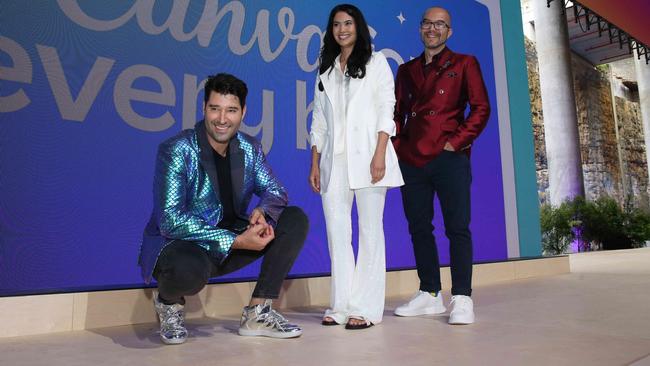Inside Canva’s plan to harness one in every five internet users
Canva believes it can harness one in five internet users, or one billion monthly active subscribers, and part of achieving that target is to change ‘boring’ communications within companies.

Canva wants to rapidly overhaul the “extremely boring” internal communications at the world’s largest companies, as its co-founder calls for a “wartime” approach to the way companies manage staff.
The move is part of a broader plan to reach one billion monthly active users – or one in five people on the internet – a figure that’s a little more than five times what the Australian design giant currently has.
Cliff Obrecht told a crowd at Morgan Stanley’s Australia Summit on Wednesday that: “Most internal communication is extremely boring but given how easy it is to create groupings of visual content now, it doesn’t need to be.”
Weeks ago the company launched an overhaul of its entire platform, redesigning it to take on the far larger and more lucrative enterprise market.
Poor internal communications weren’t just bad for culture but often left employees unmotivated, Mr Obrecht said.
“There’s some studies and data that supports this … employees leave companies because of outdated internal communications and because of the tools that they have to use,” he said.
Canva wasn’t just targeting a company’s marketing team but also its human resources. Central to this is a new product called courses that would allow companies to incorporate compliance training – from security to sexual harassment – and turn it into visually appealing course work.
“It also allows the people team or the HR team to track who’s done what,” Mr Obrecht said.
Under Canva’s new enterprise strategy, data plays a key role, Mr Obrecht said, adding that Canva was building ecosystems inside major companies where analytics tracked how communications and course work performed.
“(Our goal is for) you to actually have an ecosystem where that content lives and can be easily accessed and consumed and (companies will have) the data behind who’s consuming that, how they’re consuming that ...,” he said.

The company was also considering how its products integrate with other major enterprise technology companies such as Salesforce.
“It’s all about these workflows,” he said. “You want to automate the creation, you want to link in your Salesforce or other CRM into your content creation platform so you can create customised presentations to everyone of your prospects, email blast them out and understand what’s been open and follow up with them.”
The company had recently brought on about 1000 new staff as well as a new chief customer officer, Rob Giglio, who has arrived from the same role at HubSpot.
Canva had been able to hire at a time when many tech companies were retracting because of what Mr Obrecht described as a “wartime” mentality.
“I like to always have a sort of wartime mentality lens when it comes to talent management,” he said.
“As much as there needs to be propagating and rewarding of high performers, you need to be constantly looking at low performers and accurately managing those people out of your company in order to keep that performance bar high.”
Mr Obrecht said Canva turned down suggestions from venture capitalists and other investors to take on more capital during 2021 and to rapidly hire more staff.
But it had also been guilty in its early days of hiring fast – a move which often allowed low performers to go unnoticed.
“We’ve certainly been guilty of this in the early days … Over hiring means you do not put pressure on low performers because the additional headcount covers up a gap that some people were leaving,” he said.
“If you essentially prune the tree as it grows, you’re in a much stronger position and when tough times inevitably come, you’re not forced to do massive cutbacks.”







To join the conversation, please log in. Don't have an account? Register
Join the conversation, you are commenting as Logout